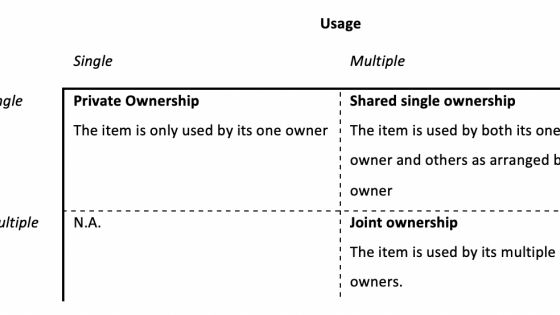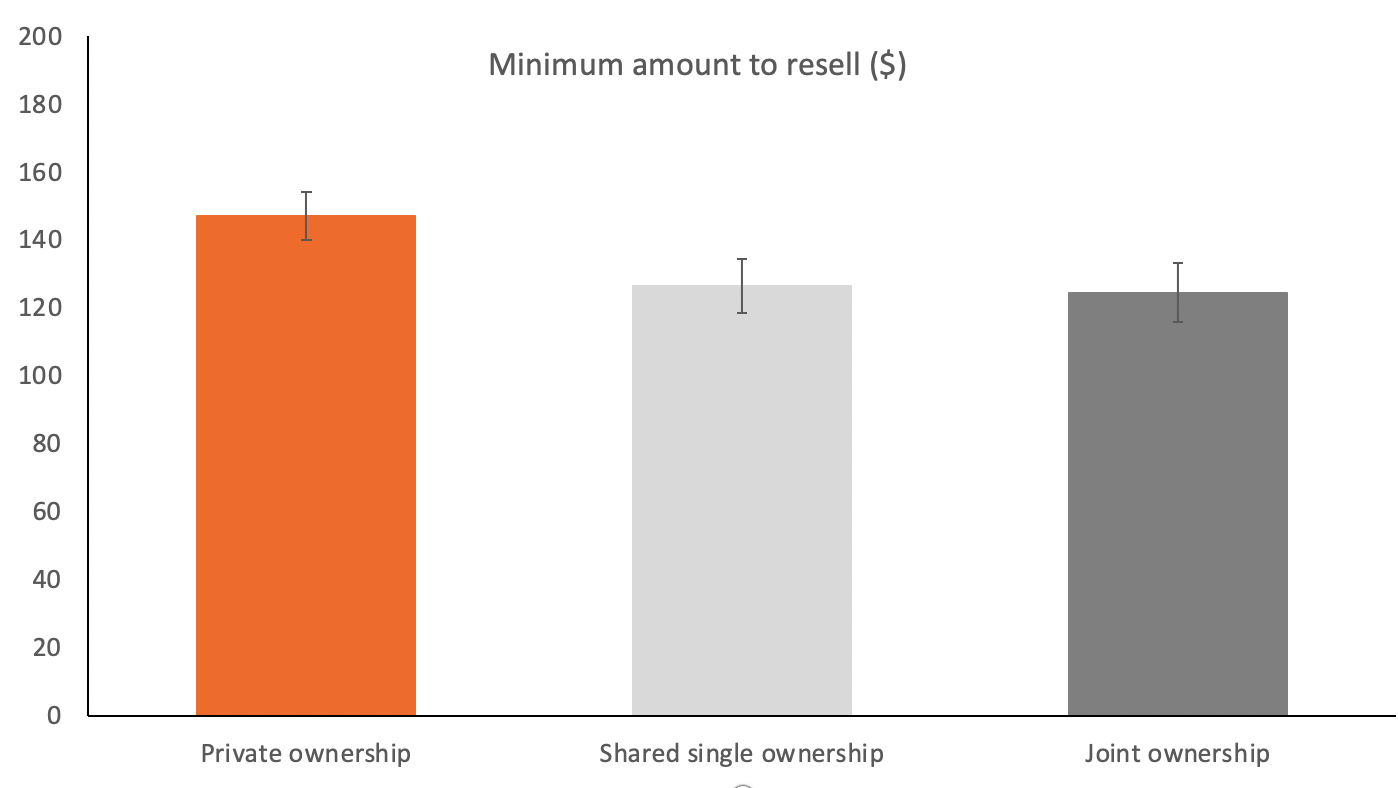Sharing between consumers has grown in popularity and adoption, following a societal trend towards the sharing economy. Sharing is an ancient and universal form of behaviour (Price 1975) in which people grant others temporary access to their possessions. Sharing can involve payment (Frenken and Schor 2017) but in its purest form does not need to be reciprocal (Belk 2010).
Many of us have some experience with non-reciprocal, consumer-to-consumer (C2C) sharing arrangements, whether lending a lawnmower to a neighbour or buying and sharing a car with friends. We distinguish two distinct types of non-reciprocal C2C sharing (see Table 1). In a shared single ownership arrangement, the owner buys the item and allows others to use it for free. In a joint ownership arrangement, all users buy the item together and all partial owners can use it. These two types of non-reciprocal sharing are different from the classic form of private ownership, in which one person is the sole owner and user. A commonality across the three distinct forms of ownership, however, is that they require owners (not users) to make major decisions regarding the product. After purchase, owners manage maintenance and make the decision of when to end use (e.g. disposal, replacement, reselling). Differing ownership arrangements (varying in levels of ownership and usage) may influence these decisions.
Table 1 Ownership and usage types
In a recent ING study, we explored the influence of shared usage in C2C sharing arrangements on products’ end of use decisions (Straeter and Exton 2020). Although sharing is believed to be sustainable, it appears that this view is too rosy. Products are disposed of earlier when shared with other people, irrespective of the frequency of use.
Why would owners treat their items differently when jointly owned or shared with others? Owners might perceive the physical state of shared products differently. Obviously, multiple users can lead to the intensified use of a product (Plepys and Singh 2019), but the perceived physical state doesn’t depend purely on usage frequency. Products that have been in contact with other consumers are viewed as contaminated, even when the product has objectively been unharmed (Argo et al. 2006). After physical contact, the essence of a user is transferred to – and remains part of – the product (Nemeroff and Rozin 1994), eliciting a feeling of disgust (Rozin et al. 1986, Rozin and Fallon 1987, Argo et al. 2006). The stronger a cue signals contact between another consumer and a product, the greater the chance that people will perceive that product to be contaminated. Shared usage of a product might cause owners to perceive it as contaminated and throw it away earlier than products that are not shared.
But the owner’s end of use decision may also be affected by their level of ownership (joint versus private). Consumers are known for having difficulty letting possessions go. Once people own an item, they become attached to it and adverse to ending its use (Thaler 1980, Kahneman et al. 1990) driving a range of consumption decisions. Attachment to an item could be reduced with shared ownership, meaning that owning a portion of an item (i.e. joint ownership) makes people feel less connected to the item and more likely to be distanced from it. Nonetheless, it is also reasonable to suggest that people are similarly attached to items that are jointly and privately owned. A shared product can still be considered part of the aggregated extended self and provide meaning to one’s identity (Belk 2010).
Although the strength of the attachment to shared products may be slightly less, the attachment in itself still influences end of use decisions. This would mean that similar to private ownership and shared single ownership, which are both characterised by a single owner, owners of joint possessions will feel attached to their items as well, finding it hard to distance themselves from the items and valuing them highly. So, we presumed that shared usage, not shared ownership, of a possession increases the willingness to end product use.
The studies
In our research, we compared how willing people were to throw away, replace, or resell an item (a mountain bike or lawn mower) which they privately owned, privately owned and shared, or jointly owned and shared. At all times the frequency of usage was kept the same. We ran two online experiments with 413 adults in the US and, as expected, found that people were more willing to end the use of an item that was shared with others (see Figures 1 and 2). Items were least likely to be thrown away, replaced, or resold when people were the sole owner and user. No difference was found between owners who were the sole owner but shared usage and owners who jointly owned the item and shared usage, meaning that shared usage and not shared ownership drives end of use decisions.
Figure 1 Intention to dispose and to replace across conditions
Note: Error bars represent ± 1 standard error.
Figure 2 Minimum amount to resell ($) the mountain bike across conditions
Note: Error bars represent ± 1 standard error.
Our findings can be explained by the perceived contamination of an item (Argo et al. 2006). Items that are touched by others are viewed as contaminated, even when they are unharmed (Argo et al. 2008). The essence of other users is still transferred onto the product. Indeed, our data showed that people perceived their items to be the least contaminated when they were the sole owner and user. The level of perceived contamination was higher for items that were shared, but across the two sharing arrangements (shared single ownership and joint ownership) no difference was found. A mediation analysis revealed that perceived contamination (partially) explained the owner’s willingness to end the use of a possession.
A double-edged sword
So, although the nature of the sharing economy suggests that innovative C2C sharing-based ownership arrangements reduce environmental impact as one product services multiple users, motivating consumers to adopt them (Böckner and Meelen 2017, Hamari et al. 2015), our research emphasises that this reduction may be smaller than anticipated and identifies drawbacks to sharing items that are privately or jointly owned. Owners who share their (joint) possessions are more likely to dispose of, replace, or resell (at a lower price) these items compared to private owners and users. As a consequence, there are clear immediate environmental benefits to sharing in the form of decreases in use of raw production materials, but the long-term benefits may be smaller than expected.
This flow-on effect of sharing products is relevant to policymakers and businesses in developing sharing-based initiatives, and consumers in adopting shared products. Sharing initiatives at a local level (e.g. among neighbours) seem to be becoming more popular and are encouraged. Therefore, a good understanding of the dynamics around C2C sharing initiatives is crucial to success. Our research contributes to this understanding, but there are aspects left to explore. For example, are there C2C relationships, such as close friendships, that fit sharing better and quiet the impulse to throw away shared items faster? Is it possible to reduce the influence of perceived contamination on the disposal of shared items by an objective indicator of deterioration? And what are other additional drivers of end of use decisions? Evidently, there are many aspects of the end of use decisions regarding shared items still to be considered.
Conclusion
Our research contributes to a better understanding of the consequences of C2C sharing-based ownership arrangements and the sharing economy as a whole. Although sharing possessions can have great benefits, our findings reveal that as a flow-on effect, the sustainable outcomes might be limited in the long run.
References
Argo, J J, D W Dahl and A C Morales (2006), “Consumer contamination: How consumers react to products touched by others”, Journal of Marketing 70: 81–94.
Argo, J J, D W Dahl and A C Morales (2008), “Positive consumer contagion: Responses to attractive others in a retail context”, Journal of Marketing Research 45: 690–701.
Belk, R (2010), “Sharing”, Journal of Consumer Research 36: 715–734.
Böcker, L and T Meelen (2017), “Sharing for people, planet or profit? Analysing motivations for intended sharing economy participation”, Environmental Innovation and Societal Transitions 23: 28–39.
Frenken, K and J Schor (2017), “Putting the sharing economy into perspective”, Environmental Innovation and Societal Transitions 23: 3–10.
Hamari, J, A Sjöklint and A Ukkonen (2015), “The sharing economy: Why people participate in collaborative consumption”, Journal of the Association for Information Science and Technology 67: 2047–2059.
Kahneman, D, J L Knetsch and R H Thaler (1990), “Experimental tests of the endowment effect and the Coase theorem”, Journal of Political Economy 98: 1325–1348.
Nemeroff, C and P Rozin (1994), “The contagion concept in adult thinking in the United States: Transmission of germs and interpersonal influence”, Journal of the Society for Psychological Anthropology 22: 158–186.
Plepys, A and J Singh (2019), “Evaluating the sustainability impacts of the sharing economy using input-output analysis”, in A Research Agenda for Sustainability Consumption Governance, Edward Elgar Publishing.
Price, J A (1975), “Sharing: The integration of intimate economies”, Anthropologica 17: 3–27.
Rozin, P and A E Fallon (1987), “A perspective on disgust”, Psychological Review 94: 23–41.
Rozin, P, L Millman and C Nemeroff (1986), “Operation of the laws of sympathetic magic in disgust and other domains”, Journal of Personality and Social Psychology 50: 703–712.
Straeter, L M and J Exton (2020), “The double-edged sword of the sharing economy: How sharing ownership and usage influences sustainable consumption”, in The Behavioral Economics Guide 2020: 100–112.
Thaler, R (1980), “Toward a positive theory of consumer choice”, Journal of Economic Behavior and Organization 1: 39–60.






